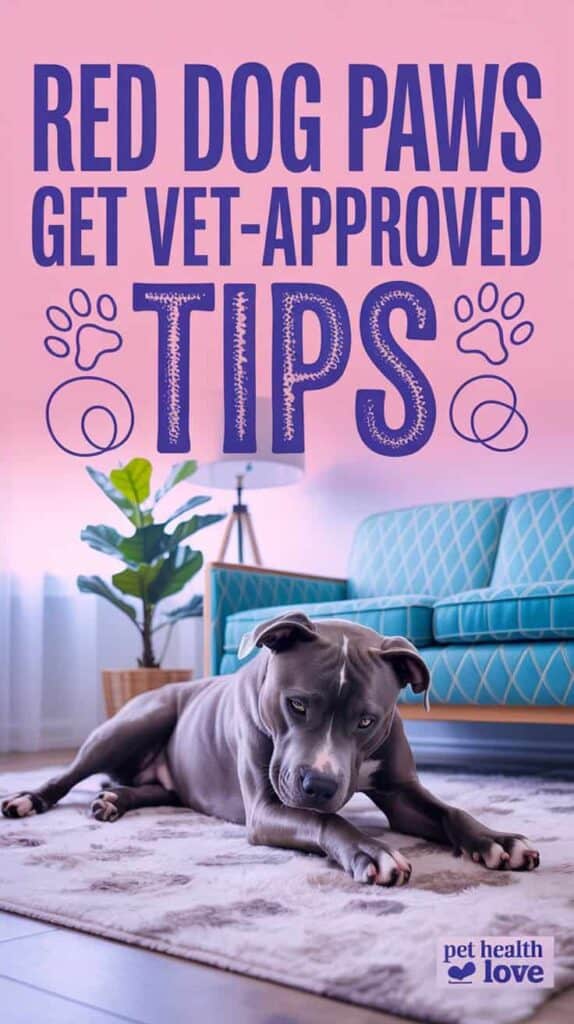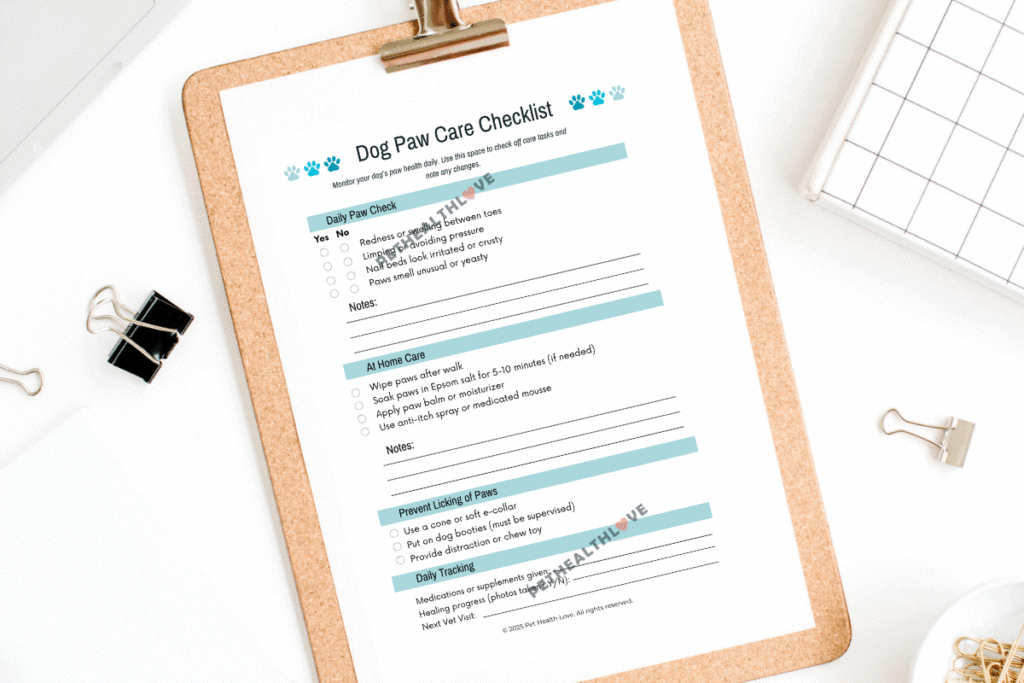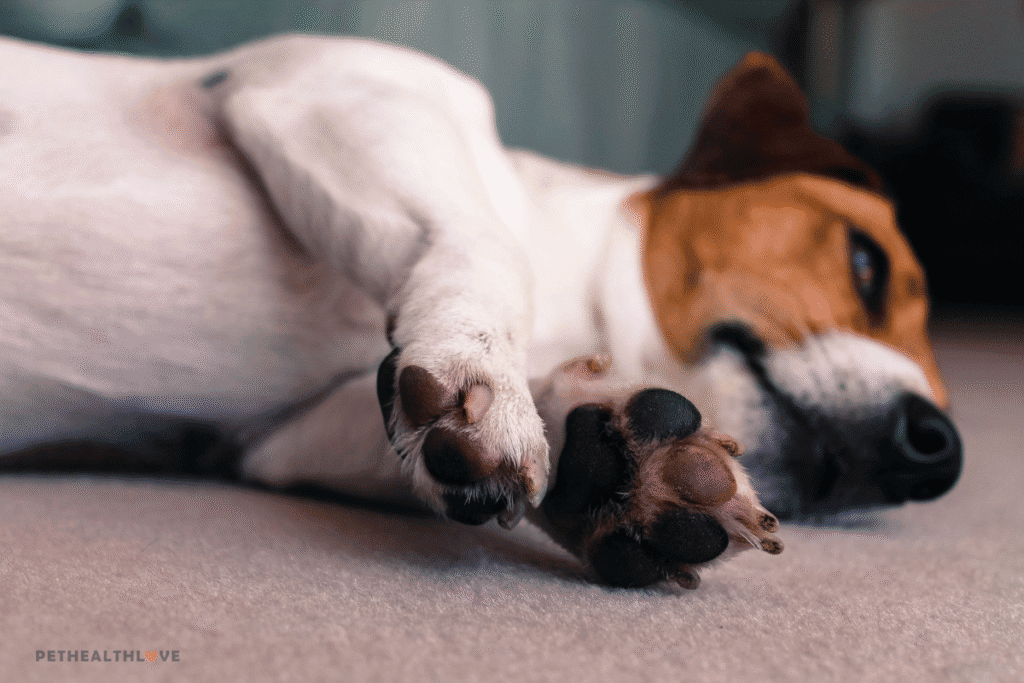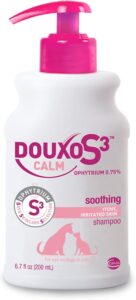Last updated on August 9th, 2025 at 10:42 pm
If your dog’s been licking or chewing at their feet nonstop, only for you to find red dog paws staring back at you, you’re not alone. As a veterinarian, I’ve seen countless cases where irritated paws were the first sign of a bigger issue—whether it was allergies, a hidden infection, or something as simple as walking on hot pavement.
Red paws can look dramatic and uncomfortable, but with the right care, most dogs bounce back quickly. In this post, I’ll walk you through the most common reasons dogs get red paws, how to treat them at home, and when it’s time to call your vet.
I’ve also created a Dog Paw Care Guide you can download from my Resource Library — it’s packed with tips to help keep your pup’s paws healthy year-round!
Affiliate Disclaimer: This post may contain affiliate links, which means we may earn a small commission if you purchase something through our links. This helps support our website and allows us to continue providing valuable content. See our full disclosure here.
Key Takeaways
- Allergies are a leading cause of red paws in dogs.
- Besides allergies, red paws can be caused by infections, such as bacterial or yeast infections, injuries, burns from hot asphalt, cold weather, or exposure to chemicals.
- Constant paw licking, chewing, swollen toes, and limping are other signs to look for when red paws are noticed.
- Seek veterinary care promptly if red paws have open sores, bleeding, or if your dog shows signs of discomfort and behavioral changes.
- Treatment will depend on the underlying cause but may include topical products for skin and prescribed medication.
- Fish oil supplements can benefit a dog’s skin health and contribute to healthier paws.
Why Does My Dog Have Red Paws?
Red dog paws aren’t just a cosmetic issue—they’re often your dog’s way of saying, “Something’s not right.” As a veterinarian, I’ve treated everything from mildly irritated pads to deep infections, and many cases start with the same thing: redness, licking, and discomfort.
Several things can trigger paw redness in dogs, from allergies and environmental irritants to injuries and infections. Figuring out the underlying cause is the first step toward relief. Let’s take a closer look at the most common reasons your dog might have red paws:
🧬 Allergies
Whether it’s food-related (like chicken or beef) or environmental (like pollen, dust mites, or mold), allergies are one of the top causes of red, itchy paws in dogs. Contact allergies—such as walking through grass or floor cleaners—can also lead to inflamed paw pads. Many allergic dogs will lick their feet obsessively, which only makes the redness worse.
In my clinic, allergy season brings a wave of dogs with red, itchy paws. I often see grass and pollen trigger the licking—and food allergies can do it too.
🦠 Infections (Bacterial or Yeast)
Moist environments and constant licking create the perfect setup for bacterial or yeast overgrowth. You might notice a bad smell, greasy residue, or brownish staining on the fur between the toes. These infections often need prescription treatments from your vet.
☀️ Weather and Environmental Factors
Hot pavement in the summer can burn delicate paw pads, while winter air and road salt can dry them out and cause cracking or redness. If your dog walks a lot outdoors, environmental exposure may be the culprit.
🧪 Chemical Irritants
Household cleaners, lawn treatments, de-icing salts, and even some shampoos can trigger red paws. These substances can be irritating or even toxic, especially if your dog licks their feet afterward.
🐾 Injuries or Foreign Bodies
Tiny cuts, abrasions, or embedded objects like splinters or foxtails can cause localized redness and swelling. If your dog is limping or favoring one paw, look between the toes or under the pads for signs of trauma.
Be sure to subscribe at the bottom of this post to get instant access to my FREE Dog Paw Care Checklist — plus dozens of other pet care printables in my Resource Library!
When Red Paws Aren’t the Only Symptom – What Else to Look For
Red dog paws are often just the beginning. As a veterinarian, I always tell pet owners that the paws can reveal a lot—if you know what to look for. Checking your dog’s paws regularly (especially during grooming or cuddle time) can help catch problems early.
Here are some other signs that often show up alongside red paws:
Excessive Licking or Chewing
If your dog won’t stop licking, chewing, or biting at their feet, it’s usually a sign of itchiness or discomfort. This behavior can actually make red paws worse by introducing bacteria or yeast.
Swelling and Warmth
Gently feel your dog’s paws. Swollen areas may appear puffy or feel warmer than the rest of the foot—both signs of inflammation or infection.
Limping or Favoring a Paw
Is your dog avoiding putting weight on a foot? Limping, skipping steps, or walking “funny” could signal that a specific paw is painful or injured.
Behavior Changes
Reluctance to walk, avoiding play, hiding, or seeming grumpy may all stem from sore feet. Many dogs won’t cry out in pain—but they’ll show it through changes in behavior.
Paw Sensitivity
If your dog pulls away, whines, or tries to hide their foot when you touch it, they’re likely experiencing discomfort. Don’t force an exam if they’re in pain—use treats, a calm voice, and get help from your vet if needed.
When to See the Vet for Red Dog Paws
Sometimes red paws can be managed at home—but not always. As a veterinarian, I often see cases where pet parents waited just a little too long, thinking the redness would go away on its own. The truth is, red dog paws can go from mild to infected in just a few days, especially if your dog keeps licking or walking on irritated skin.
So how do you know when it’s time to book that appointment?
Here are signs you shouldn’t ignore:
The redness hasn’t improved after 2–3 days of home care
The paw is swollen, bleeding, or has raw sores
Your dog is limping or reluctant to put weight on the paw
You see pus, crusting, or a bad smell (often a sign of infection)
Your dog won’t stop licking, chewing, or biting at the paw
They yelp or pull away when you try to examine the foot
More than one paw is affected (this often points to a systemic issue like allergies)
Getting ahead of these signs can prevent complications like deep infections, pain, or even the need for sedation to fully treat the paw. If you’re unsure, trust your gut—it’s always better to have a vet take a look than to wait it out and risk things getting worse.
How to Treat Your Dog’s Red Paws – 10 Vet-Recommended Actions
When your dog’s paws are red, irritated, or inflamed, acting quickly can make all the difference. As a veterinarian, I often guide pet parents through these same steps at home to help relieve discomfort and prevent things from getting worse. Below are 10 simple, effective ways to treat red dog paws and support healing.
1. Inspect the Paws Closely
Gently examine your dog’s feet, especially the nail beds, between the toes, and the paw pads. Look for redness, swelling, cuts, thorns, or signs of infection like pus or odor.
2. Soak in Epsom Salt
Mix warm water with Epsom salt and soak the affected paws for 5–10 minutes. This can reduce swelling, ease discomfort, and draw out minor irritants.
3. Apply a Pet-Safe Paw Balm
Moisturizing balms help soothe cracked or dry pads and act as a barrier against further irritation. Look for natural, dog-safe formulas.
4. Use an Anti-Itch Spray or Aloe Gel
A cooling spray or aloe vera gel made for pets can help reduce itchiness and inflammation. Avoid any products with alcohol or harsh chemicals.
5. Keep Paws Clean
Use hypoallergenic pet wipes or a gentle, dog-safe shampoo to remove allergens, dirt, or salt after walks. Daily cleaning helps prevent secondary infections.
6. Use Dog Booties Outdoors
Booties protect sensitive paws from hot pavement, cold weather, or rough terrain. They’re especially useful if your dog has recurring paw irritation.
7. Check the Environment
Scan your yard, walking routes, or favorite dog spots for hazards—like sharp rocks, thorns, prickly plants, or chemical-treated grass.
8. Add Omega-3 Fatty Acids
Fish oil or omega-3 supplements support skin health and may reduce inflammation linked to allergies. Ask your vet about a trusted product and dosage.
9. Prevent Licking with a Cone or Recovery Collar
Dogs often make things worse by licking or chewing their paws. A soft or traditional e-collar can give the skin a chance to heal.
10. Call Your Vet If Things Don’t Improve
If the redness gets worse, spreads, or doesn’t improve within a few days, it’s time for a professional evaluation. Your vet may prescribe medication or identify an underlying cause.
Vet Tip: Red paws are often a symptom—not the root cause. These steps can help soothe irritation, but if your dog’s licking returns again and again, you may be dealing with allergies or chronic skin conditions.
What Your Vet Might Do for Red Dog Paws
If home care isn’t enough, your veterinarian has more advanced tools to help your dog feel better. In my practice, I’ve treated countless cases of irritated, itchy paws—many of which needed more than paw balm or booties. Here’s what you can expect if your dog needs veterinary intervention:
💊 Prescription Medications
Depending on the cause, your vet may prescribe anti-inflammatory meds like Apoquel or Cytopoint, along with antibiotics or antifungals if there’s an infection.
UPDATE:
New Allergy Medication for Dogs: Zenrelia
Zenrelia is a new once-a-day tablet approved to treat itching and skin allergies in dogs. It helps calm the immune system and break the itch-scratch cycle, especially in dogs with conditions like atopic dermatitis.
In studies, dogs taking Zenrelia had less itching and fewer skin flare-ups than those on older allergy medications like Apoquel. Many owners also liked that it only needs to be given once a day from the start—no twice-a-day loading dose.
💡 Things to Know
- Zenrelia works fast and keeps working long-term.
- It’s often more affordable than similar options.
- Dogs on Zenrelia should not get vaccines while on the medication or for about 3 months after stopping.
🧴 Medicated Topical Products
We often recommend medicated mousses, shampoos, or sprays (like chlorhexidine or ketoconazole blends) to calm the skin and reduce microbial overgrowth.
🥩 Food Trials for Allergies
If we suspect a food allergy, we may recommend switching to a hydrolyzed or limited-ingredient diet for several weeks to rule out dietary triggers.
🩹 Bandaging and Wound Care
For dogs with open sores or cuts, bandaging and proper wound cleaning are sometimes needed—especially if they won’t leave their paws alone.
Pro Tip: Bring photos or videos of the paw when it’s at its worst. Skin issues tend to fluctuate, and it helps your vet see what you’re seeing at home.
How to Prevent Red Dog Paws in the Future
Once your dog’s paws are back to normal, the next step is keeping them that way. Over the years, I’ve found that a few simple habits can make a big difference in preventing flare-ups—especially in dogs with allergies or sensitive skin.
🐾 Vet-Recommended Prevention Tips
Do a quick paw check after every walk. Look for redness, cuts, thorns, or stuck debris between the toes. Catching issues early can prevent infections.
Use dog booties during hot summer days or icy winter walks. Paw pads can easily burn or crack without protection.
Avoid treated lawns and chemical areas. Pesticides, fertilizers, de-icers, and cleaning solutions can irritate your dog’s paws—and become dangerous if licked.
Walk during cooler hours when sidewalks are less likely to burn your dog’s feet. Early morning and evening are safer during warm months.
Allergy-proof your routine. If your dog has known allergies, minimize exposure to triggers—this may mean wiping paws after walks or adjusting their diet with your vet’s help.
Keep your home and yard clean and paw-safe. Remove sharp rocks, thorns, broken glass, or other hazards from your dog’s play areas.
Final Thoughts
Red dog paws are more than just a minor irritation—they’re your dog’s way of saying something’s wrong. Whether it’s allergies, an infection, or too much time on hot pavement, the key is catching the problem early and knowing how to help.
With a little awareness, regular paw checks, and the right preventive care, you can keep your dog’s paws healthy and comfortable year-round. Most cases can be managed at home, but don’t hesitate to call your vet if something doesn’t look or feel right.
As a veterinarian, I’ve seen just how much happier and more active dogs are when their feet feel good. Healthy paws mean more play, more walks, and more tail wags. And that’s something we all want for our pups.
FAQs
1. What can I expect when I take my dog to the Vet for his red paws?
Your veterinarian will perform a full physical exam and check the paws for redness, swelling and foreign material. Certain tests to look for an excess of bacteria and yeast may be done. Depending on those results, anti-inflammatories, antibiotics, or antifungal medications may be prescribed. Certain topical products may be recommended, including medicated shampoos, mousses, or anti-itch spray. For open sores or wounds on the paws, placing a soft bandage may be needed. Ideally, your dog may have to wear an Elizabethan collar (or cone) temporarily to prevent licking or chewing.
2. Is it essential to groom my dog’s paws regularly, and how do I do it properly?
Regular paw grooming is important for your dog’s overall health and well-being. Proper paw care can prevent issues like red paws, infections, and discomfort. Here are a few things you can do:
- Trim your dog’s nails routinely using a dog-specific nail clipper. Be cautious not to cut too close to the quick, as it can cause bleeding and pain.
- Gently clean your dog’s paw pads with a damp cloth to remove dirt and debris. Pay attention to the areas between their toes.
- Apply a pet-safe paw balm to keep their paw pads moisturized and prevent dryness.
- Routinely check for any foreign objects like splinters, thorns, or debris that might be lodged in their paws.
3. Can certain dog breeds be more susceptible to developing red paws?
Some dog breeds are more prone to developing red paws due to various factors such as skin sensitivities, allergies, and genetics. English Bulldogs, Boxers, French Bulldogs, and Pugs are known to have skin folds on their faces and paws that can trap moisture and debris, potentially leading to irritation. Also, smooth, short-coated breeds like Dachshunds and Great Danes are commonly found to develop red paws. However, any dog can experience red paws regardless of their breed, so it’s important to provide proper care for all dogs.
4. Is it safe to use over-the-counter medications for my dog’s red paws?
Using over-the-counter medications for your dog’s red paws is not recommended without consulting your veterinarian first. Some human medications, including creams and ointments, may contain ingredients like zinc oxide or essential oils that could cause stomach upset when ingested or irritation to the mouth or skin. Always seek professional veterinary advice before administering any medication to ensure the safety and appropriate treatment for your dog’s red paws.
Sources:
- Cote DVM DACVIM(Cardiology and Small Animal Internal Medicine), E. and Leah Cohn DVM PhD DACVIM (SAIM). Clinical Veterinary Advisor: Dogs and Cats. 4th Edition. Elsevier. 2019.














Leave feedback about this